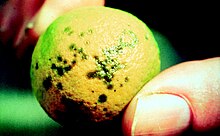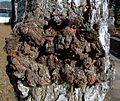Tree crab
As canker plant diseases are referred to, which are caused by the infection of the bark and the wood with the bacteria or fungi. It is not a circumscribed disease. Rather, the diseases summarized under this term are characterized by very similar symptoms. Contrary to what the name suggests, it is not cancer in the medical sense, i.e. uncontrolled growth of cells. Instead, the term cancer comes from the fact that infected plants react by creating a lot of wound tissue, which they use to try to overwhelm the wounds caused by the infection . This creates growths on twigs, branches or the trunk that can reach a considerable size.
Symptoms
The tree canker pathogens generally first penetrate the plant tissue through small bark wounds. The bark over the site of infection changes color and breaks, creating an open wound. The wood tissue below the infection site becomes necrotic and discolored.
The infected plant tries to overwhelm the wound by increasing the formation of wound tissue ( callus ). Due to the aggressiveness of the infection, however, it gets deeper and deeper, which stimulates the plant to further callus formation. This can result in large and voluminous tissue growths.
Due to the dead tissue, the supply of nutrients and water to the branches above the cancerous wound is no longer guaranteed. Depending on the depth of the wound, these areas can wither and die.
Economical meaning
The infection weakens the plant to a greater or lesser extent, depending on the type and severity of the disease. If the location of the wounds is unfavorable, e.g. B. on the trunk or on one of the leading branches, the host plant can die. Infested trees can often get very old despite the disease.
In fruit-bearing trees, the fruit can also be infected, which is of poor quality and has a reduced shelf life. Examples of this are fruit tree cancer and citrus cancer.
The strong callus formation leads to overgrowth. The necrotic tissue in the area of the cancerous wounds turns dark. The growths and discoloration lead to an impairment of the wood quality and thus to a loss in value of the infected trees.
Diseases and pathogens
The term tree cancer refers to diseases. Some are listed here as examples.
Bacterial infections
- Ash cancer caused by the bacteria Pseudomonas savastanoi and Pseudomonas syringae
- Bacterial cancer of the horse chestnut caused by the bacterium Pseudomonas syringae pv. Aesculi
- Citrus cancer, caused by the bacterium Xanthomonas axonopodis , affects various species of the genus Citrus
- Poplar cancer caused by the bacterium Xanthomonas populi
- Kiwi cancer caused by the bacterium Pseudomonas syringae pv. Actinidiae
- Tubercle disease of the olive caused by Pseudomonas syringae subsp. savastanoi pv. oleae
Fungal infections
- Maple stem cancer caused by Eutypella parasitica
- Fruit tree cancer caused by the pustular fungus Neonectria ditissima , the host spectrum includes numerous other trees of various genera
- Cancer of the butternut caused by the fungus Sirococcus clavigignenti-juglandacearum
- Chestnut crayfish caused by the hose fungus Cryphonectria parasitica
- Cypress cancer caused by the fungus Seiridium cardinale
- American Gleditschia cancer caused by the fungus Thyronectria austro-americana
- Larch cancer , caused by the larch crab cup fungus ( Lachnellula willkommii )
- Oak cancer, caused by the fungus Botryosphaeria stevensii , whose host spectrum also includes other tree species
- Pine cancer caused by the rust fungus Melampsorella caryophyllacearum
- Sycamore cancer caused by the fungus Ceratocystis fimbriata f. sp. platani
- Marssonina disease of the willow tree caused by the fungus Marssonina salicicola
- Cancer of the sycamore maple caused by Fusarium fungi
- Leucostoma cancer of drupes caused by the fungus Leucostoma persoonii
gallery
Tree cancer on an elm
Tree cancer on a birch
Tree crab on a butternut
Apple tree with tree crab
Tree crab on a cherry tree
literature
- Heinz Butin : Diseases of the forest and park trees. Diagnosis, biology, control. Ulmer, Stuttgart 2011, ISBN 978-3-8001-7636-6 .
Web links
Individual evidence
- ↑ a b c cancer. In: Adalbert Griegel: My healthy orchard . 8th revised edition, Griegel-Verlag 2001, pp. 36–37
- ^ Cylindrocarpon rot of apples and pears caused by Nectria galligena Bresad. In: Anna L. Snowdon: Color Atlas of Post-Harvest Damage to Fruit and Vegetables. Volume 1: General Basics - Fruit. Ferdinand Enke Verlag, Stuttgart 1995, pp. 184-185
- ↑ a b T.R. Gottwald: Citrus canker. The Plant Health Instructor. from the homepage of the American Phytopathological Society, accessed March 26, 2016
- ↑ Pseudomonas syringae pv. Actinidiae - Bacterial canker of kiwifruit. ( Memento of the original from April 7, 2016 in the Internet Archive ) Info: The archive link was inserted automatically and has not yet been checked. Please check the original and archive link according to the instructions and then remove this notice. on the homepage of the European and Mediterraneaen Plant Protection Organization (EPPO), accessed on March 27, 2016
- ↑ Roland Engesser: The plane tree shrimp. In: g'plus - the gardening journal. 2011, p. 2
- ^ Marssonina disease in Salix. on the homepage of the public green plant protection information center of the Gießen regional council, accessed on March 26, 2016
- ↑ Gitta Langner, Ulrich Bressem, Michael Habermann: Increased fungal diseases on sycamore in north-west Germany. In: AFZ-DerWald. 6/2013, pp. 22-26









